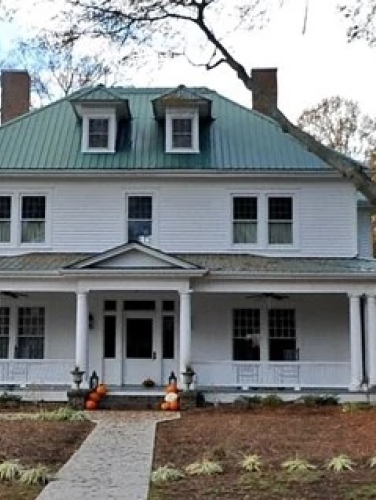
Ranson House
(ca. 1913)
Once the centerpiece of a 3,200 acre dairy farm, the Ranson House was the first Huntersville residence to have indoor plumbing, electricity, and a telephone.
412 S Old Statesville Rd, Huntersville, NC 28078
The Ranson family was one of the first families to settle in the community that would become Huntersville, so named in 1873 after another family of early local settlers, the Hunters. Originally from Anderson, South Carolina, the Reverend Alexander Ranson was a graduate of Erskine College and the Associate Reformed Presbyterian (A.R.P.) Theological Seminary. He was called to the area (then named Craighead after Revolutionary War patriot and preacher Alexander Craighead) to serve the joint pastorates of Gilead and Prosperity A.R.P. churches in 1856. Around 1872, Reverend Ranson’s nephew William Joseph Ranson (1859-1943) came to live and work with his older brother in Huntersville, operating the family cotton gin. William eventually purchased a one-half interest in the Ranson Brothers Gin Company. When his brother retired from the business for health reasons, William received the other half ownership interest, leaving him to operate Huntersville’s principal cotton gin.
Property Quick Links
In November 1890, William married Ellen Viola Hunter (1867-1936), creating a union between the town’s two most prominent families. Members of the two families owned a variety of local businesses. The Hunters owned a store and other commercial concerns near the railroad track, while the Ransons had a mill and several stores of their own. William and Ellen had nine children and in 1913 settled off Watkins Street, one block away from the railroad tracks. The couple hired Cornelius contractor Will Potts to build them a large farmhouse at the intersection of Old Statesville Road (then the town’s main business street) and what is now Mt. Holly/Huntersville Road at the southern end of town. The home, one of the earliest Colonial Revival houses in the area, emerged as a massive box frame with a wraparound veranda featuring porch pediments and classical columns. Constructed of durable, kiln-dried Georgia heart pine, the house featured numerous embellishments – including dark mahogany interior woodwork and ornate pressed tin ceilings – and was the first in town with indoor plumbing, electricity, and a telephone.
Once the centerpiece of a 3,200 acre dairy farm, the Ranson House remained in the family for nearly ninety years. The farm was also home to William’s cotton ginning business that he ran until the 1920s. Over the years, the family sold off most of the property, but the house served as an important social landmark for Huntersville for decades. In the 1970’s the downstairs level of the house was converted into apartments that were rented out by the Ransons. Yet the Ranson House remains as an important symbol of Huntersville’s agrarian past and of two important families that shaped the early economic, social, and religious life of the community.

